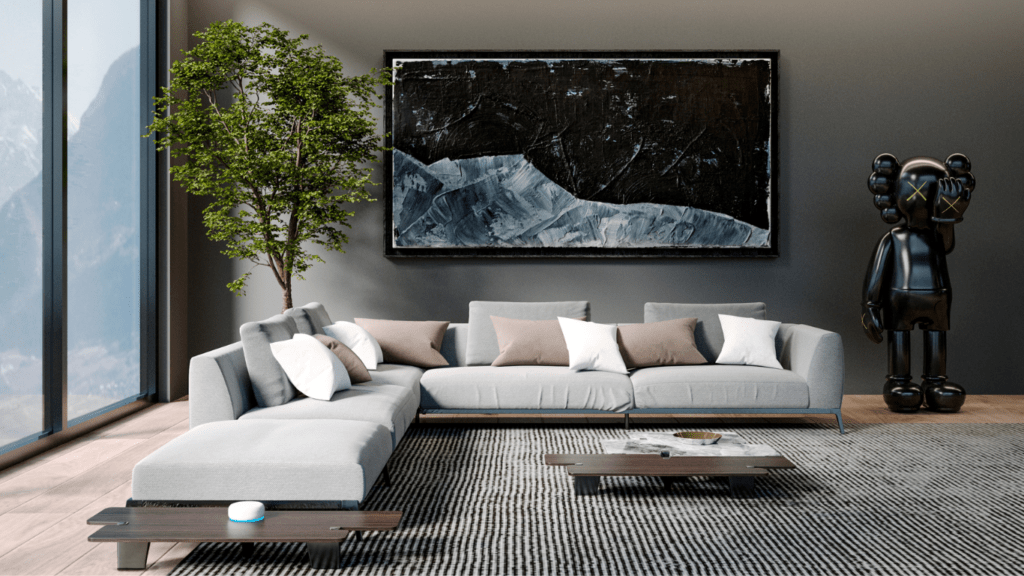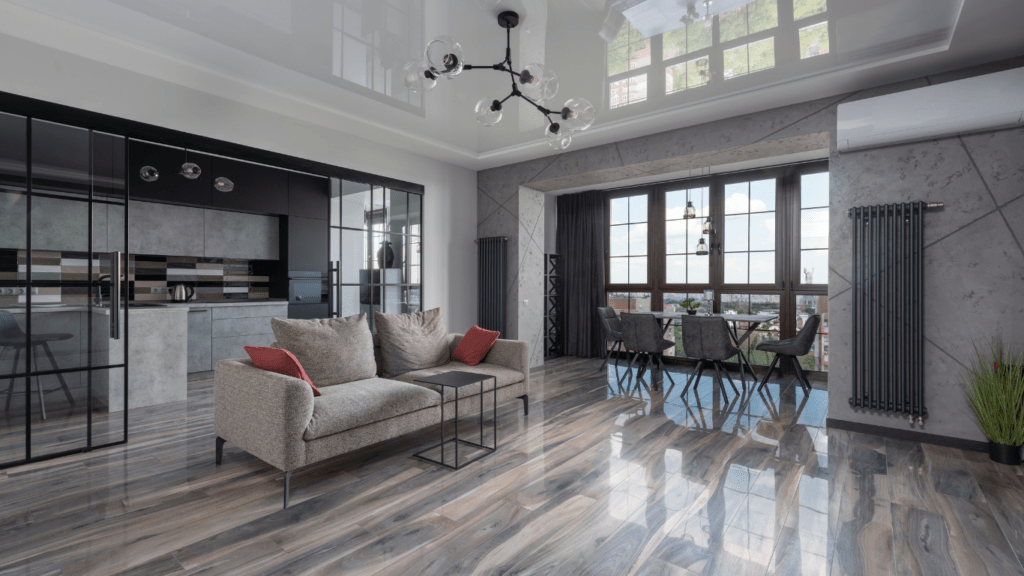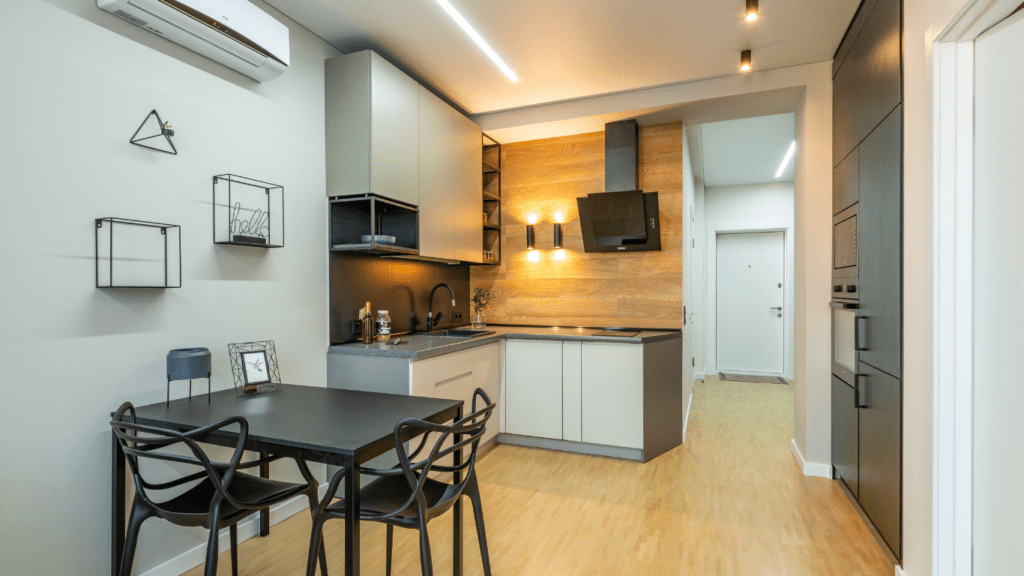Understanding Your Space
Creating the perfect furniture layout starts with understanding your space. It’s essential to consider various elements like room dimensions and functionality to design a cohesive and practical arrangement.
Analyzing Room Dimensions
Measuring each room is the first step. Get the room’s length, width, and height, noting architectural features. Include elements like windows, doors, and built-in fixtures in your measurements because these impact where furniture can go. Next, create a scaled floor plan using graph paper or a digital tool to visualize potential layouts.
Defining Functionality
Determine how you’ll use each room. Will it be a dining area, a living room, or a home office? Each function requires specific furniture and arrangements. For living rooms, consider seating arrangements that facilitate conversation, incorporating sofas and chairs in a circular or semi-circular layout. For dining rooms, prioritize a table that leaves enough space for movement around it. If it’s a home office, ensure there’s a functional workspace with sufficient lighting and storage.
By analyzing room dimensions and defining functionality, you can plan a furniture layout that maximizes both style and efficiency.
Choosing the Right Furniture
To create a home that reflects personal style and comfort, selecting the right furniture is key. Each piece should serve a purpose and align with the room’s function.
Selecting Essential Pieces
Choosing essential furniture starts with identifying the primary function of the room. For example, living rooms need sofas, coffee tables, and TV stands, while dining rooms require tables and chairs. Starter pieces form the foundation of any room. Look for multipurpose furniture in smaller spaces. Ottomans with storage, sofa beds, and expandable dining tables increase utility.
Considering Material and Color
Material and color impact both aesthetics and durability. Opt for materials that match the room’s use. Leather or faux leather suits living rooms due to their easy maintenance. Choose softer fabrics like microfiber or cotton for bedrooms. Colorwise, neutral tones such as beige, gray, and white provide a versatile base. They can be accented with bolder colors through accessories like:
- cushions
- rugs
- artwork
Go for darker hues in high-traffic areas to hide wear and tear.
Creating a Balanced Layout

A balanced layout harmonizes visual weight, ensures ease of movement, and enhances comfort. Achieve this equilibrium by considering focal points and flow.
Using Focal Points
Focal points anchor a room, drawing attention and providing direction for furniture placement. Start with architectural elements, such as fireplaces or large windows, or introduce bold furniture pieces, like a distinct sofa or an eye-catching art piece. Arrange seating to face these elements, creating a cohesive design. In a living room, place the sofa opposite a fireplace or window, adding chairs and tables to complement and balance the setup.
Ensuring Proper Flow
Proper flow promotes functionality and unobstructed movement through rooms. Keep walkways at least 3 feet wide to prevent crowding and discomfort. Create paths that guide movement naturally, keeping frequently used routes clear. Avoid placing large furniture pieces directly in traffic lanes; instead, arrange them to define functional zones without hindering movement. In an open floor plan, use rugs and lighting to delineate areas, maintaining an intuitive flow across the space.
Maximizing Space Efficiency
Efficiently using space isn’t just about fitting furniture into a room; it’s about creating a comfortable, functional environment. Let’s explore how to achieve this through multi-purpose furniture and clever storage solutions.
Multi-Purpose Furniture
Incorporating multi-purpose furniture can significantly enhance space efficiency. These pieces serve dual functions, saving both space and money.
- Sofa Beds: A sofa by day and a bed by night, ideal for small apartments and guest rooms.
- Ottomans with Storage: Provides extra seating, a footrest, and hidden storage, perfect for living rooms.
- Expandable Dining Tables: Adapts to different dining needs, offering more space for guests.
- Murphy Beds: Fold down for sleeping and hide away when not in use, maximizing floor space.
Clever Storage Solutions
Implementing clever storage solutions can keep a room tidy and spacious. Strategic storage helps maintain order without compromising on style.
- Built-in Shelves: Utilize wall space for storage, keeping the floor clear.
- Under-Bed Storage: Use bins or drawers under the bed to store clothes, shoes, or linens.
- Vertical Storage: Floor-to-ceiling shelving units make use of height and provide ample storage.
- Multi-Functional Furniture: Desks with drawers or benches with hidden compartments cater to both storage and daily use.
By applying these strategies, you can create a home that feels larger, more organized, and tailored to your needs.
Adding Finishing Touches
After optimizing your furniture layout, it’s time to add those final elements that complete the space. These touches enhance the overall aesthetic and make your home feel uniquely yours.
Incorporating Accessories
Accessorizing focuses on using decor pieces to reflect personality and tie everything together. Start with pillows and throws. They add texture and can introduce colors without major changes. For example, patterned pillows on a neutral sofa create visual interest.
Use wall art to establish a theme or color palette. Hang paintings, photographs, or even decorative mirrors at eye level to maintain harmony. Choose art that complements the room’s existing colors and style. For instance, abstract pieces suit modern spaces, while landscapes fit traditional settings.
Place greenery, such as potted plants and succulents, to bring life and freshness. Plants improve air quality and add organic elements. Larger plants can serve as focal points, while smaller varieties work well on shelves or coffee tables. Balance is key; avoid overcrowding any area with too many items.
Rugs serve multiple purposes. They delineate zones in open spaces, add warmth, and can be statement pieces. When choosing a rug, ensure it fits the scale of your furniture and room. A rug under a dining table should be large enough to accommodate chairs even when pulled out.



 Betsylie Sheetsin – Home Renovation Expert
Betsylie Sheetsin serves as the Home Renovation Expert at Castle Shelf House, specializing in giving practical advice for both small and large-scale home improvements. With years of experience in construction and renovation, Betsylie understands the importance of blending durability with design. Her insights into home renovation projects, along with expert advice on the latest materials and techniques, empower homeowners to tackle even the most ambitious projects confidently.
Betsylie Sheetsin – Home Renovation Expert
Betsylie Sheetsin serves as the Home Renovation Expert at Castle Shelf House, specializing in giving practical advice for both small and large-scale home improvements. With years of experience in construction and renovation, Betsylie understands the importance of blending durability with design. Her insights into home renovation projects, along with expert advice on the latest materials and techniques, empower homeowners to tackle even the most ambitious projects confidently.
